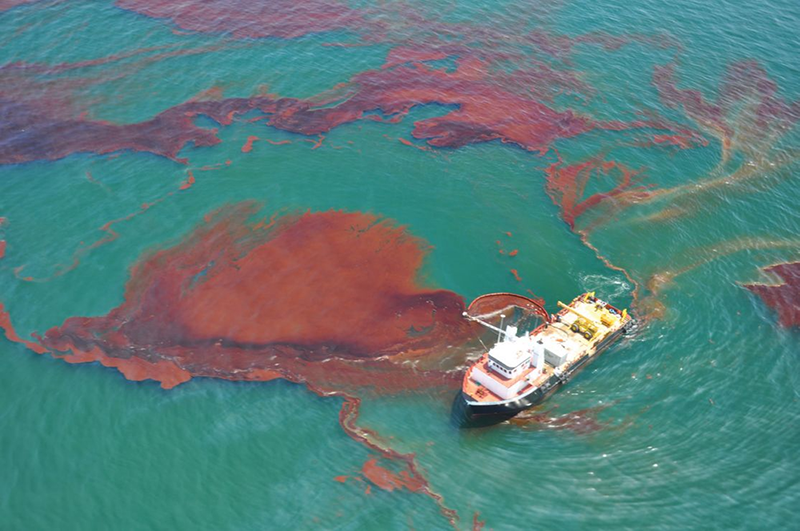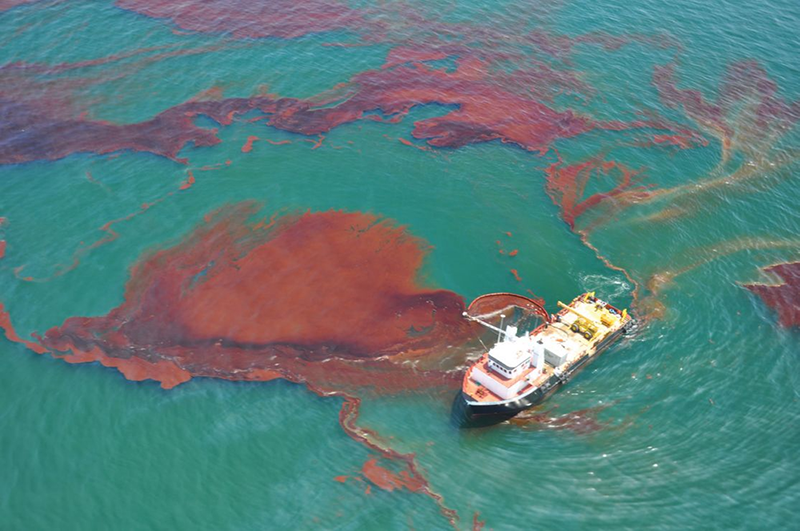Completing the Picture of How Oil Weathers in Seawater
To mitigate damage from a marine oil spill, response teams require accurate forecasts of how the oil will degrade and spread over time. Temperature and sunlight both affect the bulk properties of crude oil, but until now the relative importance of each was unclear. Now Danielle Haas Freeman, Collin Ward, and their colleagues at the Woods Hole Oceanographic Institution (WHOI), Massachusetts, report results of experiments that address that problem [1]. Their findings suggest that sunlight-weathered oil behaves differently in cold Arctic waters than in tropical oceans. The study adds a missing component to oil-fate predictions and could help guide the development of cleanup protocols that are tailored to specific environments.
Scientists know that water temperature has an influence on the mechanical properties of crude oil. Oil-spill forecasts factor in that knowledge using empirical relationships that are derived from experiments performed in the dark. But scientists also know that sunlight can impact crude oil’s mechanical properties, as well as its chemical makeup. For example, measurements of seawater recently collected from the Gulf of Mexico suggest that 8% of the oil leftover from the 2010 Deepwater Horizon explosion has transformed into water-soluble compounds by light-induced photochemical reactions of the oil. What remained uncertain was whether sunlight interacts with crude oil differently in warm and cold waters and, if so, how any difference might impact the properties of the oil.
To study this problem, Freeman, Ward, and the rest of the team performed a variety of experiments on oil samples taken from the Deepwater Horizon well and on seawater from Vineyard Sound in Falmouth, Massachusetts. The group removed from the oil components that should naturally volatilize within the first day or two of a spill. These components account for 35% of the oil’s mass, and removing them resulted in a sevenfold increase in the oil’s viscosity. The team then performed a series of temperature-dependent measurements of the mechanical properties of this evaporatively weathered oil and of seawater after it had been irradiated in a solar simulator for 120 hours (nine days). They repeated the same set of measurements on samples that had been kept in the dark.
The experiments show that both light and temperature impact the viscosity and water solubility of crude oil. For example, the team found that a sunlight-exposed sample held at 40 °C had a viscosity nearly 2 times as large as a sample that had been kept in the dark but 8 times lower than a sunlight-exposed one held at 20 °C. Similar changes were seen for the water solubility of the samples except that the direction of the change reversed: Irradiated samples held at higher temperatures contained more water-soluble content than those kept at lower temperatures. And dark ones had less that those kept in the light. “We were surprised to find that the relationships between oil properties and temperature are very different for oil that has been transformed by sunlight compared to oil left in the dark,” Freeman says.
After an oil spill, the cleanup response largely focuses on removing oil that sits atop the water. The new measurements suggest that photochemically weathered cold oil should entrain—a turbulence-induced spreading—and dissolve less than its warm counterpart. As a result, there should be more surface oil to remove for a cold-water spill than a warm-water one, but that oil will be more localized. These factors could influence how much oil might come ashore and impact coastal ecosystems. The higher viscosity of oil in a cold-water spill could also impact the response method, as the efficacy of a spill-response tool (chemical-dispersant spreading, skimming, or in situ burning) depends on the oil’s flow properties.
The results of the WHOI team show that crude oil has very different physical properties after it has been exposed to sunlight, says Matthew Tarr, an analytical chemist at the University of New Orleans who studies photochemical degradation of pollutants. He says that adding that information into oil-spill models should make the forecasts more accurate. Merv Fingas, an environmental physicist and a former chief of the Emergencies Science Division of Environment Canada, agrees with Tarr, but he questions whether the WHOI team’s findings will hold up to further interrogation. He notes that the team based the conclusions on one set of measurements and one model for the system. For example, the finding that oil entrainment is affected by sunlight is based on a model that includes entrainment. “Other models do not include this oil fate and oil entrainment is not universally accepted among oil-spill scientists,” he says.
The WHOI researchers acknowledge these comments. They say that they hope their findings will encourage other research groups to study how sunlight-driven weathering impacts the physical properties of oil spilled at sea. “Only recently has the community started to understand and embrace the importance of sunlight-driven weathering relative to other weathering processes,” Ward says. “A lot more research is needed to fully understand how and how fast oil weathers at sea and what impacts the weathering processes have on model predictions and response operations.”
In the meantime, with the higher ship traffic from increasingly ice-free summers, spills in cold Arctic waters are becoming more likely. Freeman, Ward, and the team say that the new results could help cleanup crews make decisions about how to keep those bad situations from getting even worse. Sunlight exposure can make oil spills both easier and harder to clean up, depending on where they happen, Ward says. “Oil spills are always bad, and our findings shouldn’t be interpreted as meaning that an oil spill is ‘okay’ if it happens in a certain temperature zone or with a certain amount of sunlight,” Ward says.
–Rachel Berkowitz
Rachel Berkowitz is a Corresponding Editor for Physics Magazine based in Vancouver, Canada.
References
- D. H. Freeman et al., “Hot and cold: Photochemical weathering mediates oil properties and fate differently depending on seawater temperature,” Environ. Sci. Technol. 57, 11988 (2023).





